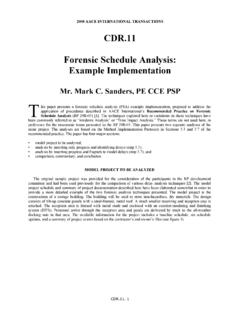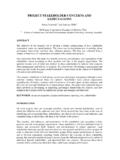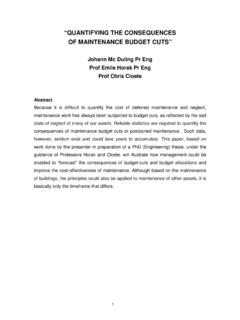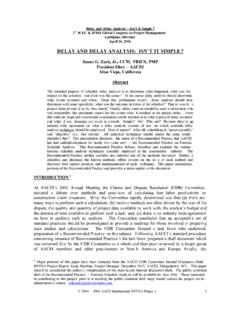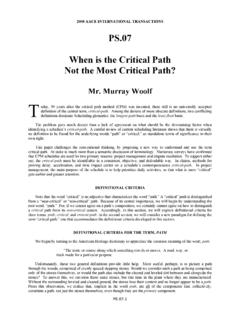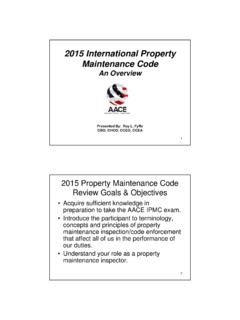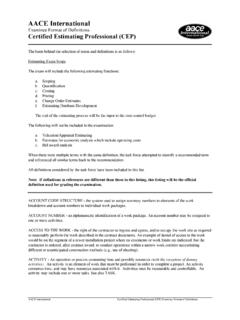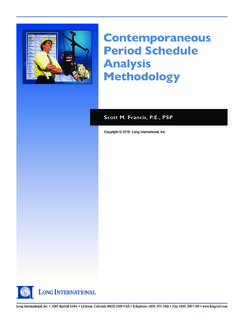Transcription of A Methodology for Estimating Engineering Details
1 W hile historical data supports the idea that engi-neering is a percent of TIC, the impact of fac-tored Engineering to a project is unclear to proj-ect managers. Too many project managers leavethis clause unchallenged and expose the project to unrealized-growth risks in cost and schedule. Factored Engineering can: Bury a significant amount of contingency; Hide behind growing scope and construction costs; Leverage project profit to the front of the project; and Avoid discussing the true cost of Engineering is a strong correlation between Engineering hours andconstruction hours. This correlation allows a project team to accu-rately forecast final project costs and schedule before the finalinvoice to the Engineering contractor is paid and before the proj-ect experiences the first project over-run forecast.
2 Engineering issolely responsible for controlling the scope of the project. Sinceconstruction hours grow three-fold for every additional hour ofengineering, there is no acceptable explanation for project over-run being forecasted when construction is halfway only explanation for a late over-run forecast is that the corre-lation between Engineering and construction is being misunder-stood or paper introduces a concept called an estimate performance can be improved through better estimatingof Engineering , by directly calculating Engineering hours frommaterial quantities, and by cross-checking with a correlation fromdirect labor hours.
3 The focus of this paper will be on calculatingengineering hours from material BASISThe techniques used for Engineering analysis and modeldevelopment are discussed in detail in "Developing EstimatingModels" [1]. The data for this paper is drawn from over one hun-dred completed refining and petrochemical projects ranging from$100,000 to $500,000,000. Absolutely no cost data was used. Theestimating Methodology is completely based on material quanti-ties and labor hours. Only discipline Engineering hours such asthose shown in table 1 are analyzed in this paper. Discipline engi-neering hours are discussed as they relate to direct labor labor does not include construction management.
4 It onlyincludes the hours that directly contribute to the asset under should be no expectation that all of the engineeringdisciplines can be modeled by a single equation. A lot of work isnecessary to take a data set and apply several data analysis tech-niques until something begins to deliver consistent results. A rela-tional database removes much of this DATAOf the hundred projects that comprise the engineeringmodel, hundreds more were discarded. There are a couple ofapproaches to filtering data. One approach is to manually discarddata that is out-of-bounds. For example, if a similar group of proj-ects all have about 20,000 hours of Engineering and one has 500hours, then the low value should be initially removed from thedata analysis.
5 The removed data point may be part of a differentanalysis, or it may be an approach is to statistically discard data. In the case ofpiping, study results have determined that direct-labor hour perpound is a strong correlation. Using statistics, data is discardedthat does not fall within one standard deviation of the averagehour per pound. Similarly, data filters can be applied to theremaining THE PROBLEMF igure 1,"Percent of Total Installed Cost vs. Project Size inMillions of Dollars," shows the result of applying a simple statisti-cal average across the entire project data population.
6 In any givenproject size, Engineering is close to both the industry average andthe expected 18 percent of TIC for refining 2 is the same data set showing the variation of the datafor each project size. The ninetieth percentile data point is repre-sented in P90. Ninety percent of the data is below this point. Theother percentile marks are handled similarly. The column forprojects less than one million dollars appears to depict an AACE International Methodology for Estimating Engineering DetailsMr. James D. Whiteside II, PEneering group that is out-of-control, thus resulting in a wide vari-ance in the Engineering hours required for a 3, " Engineering Hours vs Direct Construction LaborHours," is a graph of one hundred and 50 projects where eachwavelet is a project size class.
7 The graph is an expansion of thefirst column (Projects < $1MM) of figure 2 and demonstrates thatthere is a direct correlation between direct labor hours and disci-pline Engineering hours. Each wavelet (1-5) demonstrates thatorganizations improve efficiency as projects grow in growth in staffing occurs in step changes, represent-ed by each wavelet. For example, staffing a procurement special-ist will also require part-time staffing of contract administrators,expediters, and warehouse personnel. Most organizations can notarbitrarily use individuals for a few hours. Once a position isstaffed, the cost is incurred by the project whether or not there isenough work for that person.
8 This is French mathematician Joseph Fourier (1786-1830)demonstrated that the most general form of periodic waves couldbe built as a summation of simpler harmonic waves. A Fourierprogram was used to correlate total Engineering hours to totaldirect labor hours. Applying the Fourier principle in data analysis,as in figure 3, demonstrates that there is a strong behavioral pat-tern between Engineering and direct labor hours. The overallanalysis indicates that there are strong correlations in the TRIANGLEThis paper introduces a concept called an estimate triangle shows the balance between materials, direct laborand Engineering in the estimate.
9 If a person is given any oneaccount, the other two accounts should be easily calculated. Thebasis of the data analysis makes use of the strong and direct corre-lation between three accounts: Material to direct labor hours; Direct labor hours to Engineering hours; and Material to Engineering the plentiful labor data from completed projects,direct labor hours are easily calculated from material quantitiesand labor productivity (figure 4, side A). In examining the detaileddata for projects that perform poorly, the balance in the estimatetriangle is still satisfied. However, compared to the funding esti-mate, poor performance is due to inadequate Estimating tech-niques in the Engineering and construction accounts.
10 The esti-mate Details for each side of the estimate triangle must be asrobust as the other two has traditionally had a very robust side A, an ade-quate side B, but a poor side C. Estimating Engineering using apercent of TIC makes side C collapse. Estimate performance canbe improved through better Estimating of Engineering and bycross-checking between two sides of the is another benefit to developing an estimate of engi-neering in detail. Since direct labor and Engineering hours havea strong correlation, the efficiency between direct labor and engi-neering can be can now be analyzed in the same manner thatproductivity is analyzed for direct labor.
